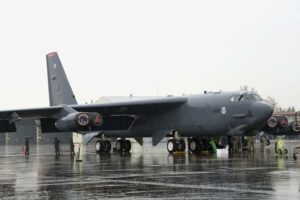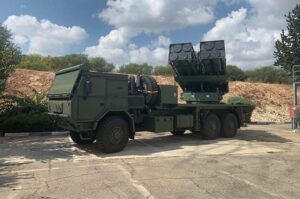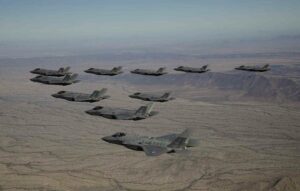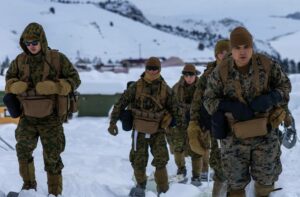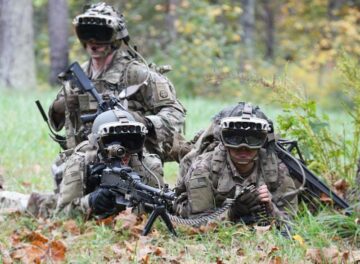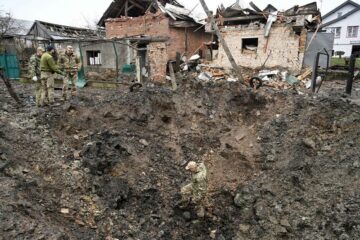AUGUSTA, Ga. — U.S. Army network specialists participating in the recent Talisman Sabre exercise in Australia successfully tested an information-sharing system that provided leaders a clearer understanding of their supplies and logistical needs.
Work on the so-called persistent common operational picture was tied to the U.S. Army Pacific, its I Corps in Washington state and potential missions in the Indo-Pacific, according to Col. Matthew Paul with the service’s Program Executive Office for Command, Control and Communications-Tactical, or PEO C3T.
“The three big questions that we had to answer, with data, were: How far can I fight? How long can I fight for? And what can I do with the assets that I have?” he told C4ISRNET on Aug. 10, ahead of the AFCEA TechNet Augusta conference in Georgia. “That required a lot of backend, data-plumbing work.”
The executive office develops and deploys communications tools used by infantry and armor alike.
Understanding where one’s supplies are and for how long they will last is critical in a fight, especially long-term. The Indo-Pacific poses unique challenges for the Army, with the region often considered the kingdom of navies. And matters are further complicated by what’s known as contested logistics — the understanding that an opposing force, like China or Russia, will target, harass and shutdown production and resupply. The Army established a Contested Logistics Cross-Functional Team in Huntsville, Alabama, earlier this year.
RELATED

The service, as part of the international exercise that wrapped up Aug. 4, planned to shuttle massive amounts of equipment across vast distances and tricky terrain, Defense News reported.
“Our goal was to try to enable that theater sustainment command, and all of the units that rely on the theater sustainment command, with technology, with a data fabric solution, with new visualizations, so they can do their job more effectively,” Paul said. “The lion’s share of our focus was more on the logistics and sustainment side of things, asset visibility in-theater. But we did venture into other domains.”
Australia led this year’s Talisman Sabre, which included 30,000-plus troops from Canada, France, Germany, Japan, South Korea, the U.K., the U.S. and more. Personnel from India, the Philippines, Singapore and Thailand observed.
It was the largest iteration in the exercise’s history, dating back to 2005.
“PEO C3T is not going it alone,” Paul said. “We’re working as part of a team.”
Colin Demarest is a reporter at C4ISRNET, where he covers military networks, cyber and IT. Colin previously covered the Department of Energy and its National Nuclear Security Administration — namely Cold War cleanup and nuclear weapons development — for a daily newspaper in South Carolina. Colin is also an award-winning photographer.
- SEO Powered Content & PR Distribution. Get Amplified Today.
- PlatoData.Network Vertical Generative Ai. Empower Yourself. Access Here.
- PlatoAiStream. Web3 Intelligence. Knowledge Amplified. Access Here.
- PlatoESG. Automotive / EVs, Carbon, CleanTech, Energy, Environment, Solar, Waste Management. Access Here.
- PlatoHealth. Biotech and Clinical Trials Intelligence. Access Here.
- ChartPrime. Elevate your Trading Game with ChartPrime. Access Here.
- BlockOffsets. Modernizing Environmental Offset Ownership. Access Here.
- Source: https://www.defensenews.com/battlefield-tech/it-networks/2023/08/14/to-nail-logistics-us-army-works-on-info-sharing-at-talisman-sabre/
- :is
- :not
- :where
- $UP
- 1
- 10
- 11
- 2005
- 2023
- 24
- 30
- 70
- a
- According
- across
- administration
- ahead
- Alabama
- alike
- All
- alone
- also
- amounts
- an
- and
- answer
- ARE
- Army
- AS
- asset
- Assets
- At
- Aug
- Australia
- award-winning
- back
- Backend
- Big
- but
- by
- CAN
- Canada
- Carolina
- challenges
- China
- clearer
- cold
- Common
- complicated
- Conference
- considered
- control
- covered
- covers
- critical
- cyber
- daily
- data
- Dating
- Defense
- Department
- Department of Energy
- deploys
- Development
- develops
- DID
- do
- domains
- Earlier
- effectively
- Electronic
- enable
- energy
- equipment
- especially
- established
- Ether (ETH)
- executive
- Executive Officer
- Exercise
- fabric
- false
- far
- fight
- Focus
- For
- Force
- France
- from
- further
- Georgia
- Germany
- goal
- going
- had
- Have
- he
- history
- How
- http
- HTTPS
- i
- image
- images
- in
- included
- india
- Intelligence
- International
- into
- IT
- iteration
- ITS
- Japan
- Job
- jpg
- Kingdom
- known
- korea
- largest
- Last
- leaders
- Led
- like
- logistics
- Long
- long-term
- Lot
- mark
- massive
- Matters
- matthew
- May..
- Military
- missions
- more
- namely
- National
- needs
- network
- networks
- New
- news
- nuclear
- Nuclear weapons
- observed
- of
- Office
- Officer
- often
- on
- operational
- or
- Other
- our
- Pacific
- part
- participating
- Paul
- Personnel
- philadelphia
- Philippines
- photographer
- picture
- planned
- plato
- Plato Data Intelligence
- PlatoData
- poses
- potential
- previously
- Production
- Program
- provided
- Questions
- recent
- region
- rely
- reporter
- required
- right
- Russia
- s
- Said
- Screen
- security
- seen
- sensors
- service
- Share
- shutdown
- side
- Singapore
- So
- solution
- South
- South carolina
- South Korea
- Speaks
- specialists
- Successfully
- system
- Target
- team
- Technology
- tested
- Thailand
- that
- The
- The Philippines
- Theater
- their
- they
- things
- this
- this year
- three
- Tied
- to
- tools
- try
- two
- U.K.
- u.s.
- understanding
- unique
- units
- us
- us army
- used
- Vast
- venture
- visibility
- war
- was
- washington
- we
- Weapons
- were
- What
- which
- will
- with
- Work
- working
- works
- Wrapped
- year
- zephyrnet

